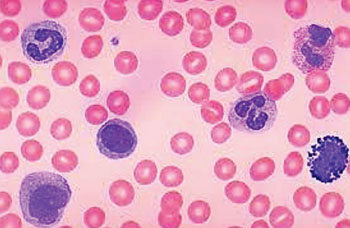Blood Tests Help Identify Children Who Need Appendectomy
By LabMedica International staff writers
Posted on 05 Mar 2015
Appendicitis is the most common abdominal surgical emergency in the pediatric population, yet the diagnosis remains challenging in many cases and the use of laboratory data as a diagnostic adjunct has similarly been associated with relatively low sensitivity, and children with pathology-proven appendicitis can often present with a normal leukocyte count.Posted on 05 Mar 2015
Two standard diagnostic tests commonly obtained in children evaluated for abdominal pain—when combined can improve the ability of emergency department physicians and pediatric surgeons to identify those patients who should be sent to the operating room for prompt removal of an inflamed appendix and those who may be admitted for observation, and those who may safely be discharged home.

Image: Various types of leukocytes within a blood sample used for a differential white blood cell count to determine the relative percentages (Photo courtesy of Dr. Kristine Krafts MD).
Medical staff at the Boston Children's Hospital (Boston, MA, USA) conducted a retrospective cohort study of 845 patients, three to 18 years of age, who were evaluated in an emergency department with a chief symptom of abdominal pain between January 1, 2010 and December 31, 2012. Negative (NPV) and positive predictive values (PPV) for appendicitis were calculated for common constellations of US findings and compared with and without the use of laboratory thresholds: white blood cell count (WBC) >9 × 103/mL and polymorphonuclear leukocyte differential (PMN%) >65% for PPV; WBC <9 × 103/mL and PMN% <65% for NPV. Ultrasound reports were reviewed using standardized definitions and case report forms.
Of the 845 children in the study, 393 (46.5%) had appendicitis. An elevated WBC count was found in 348 (62.1%) of these patients, and a PMN% shift was found in 340 (58.5%). In children who did not have appendicitis, the WBC was elevated in 212 (37.9%), and the PMN% shift occurred in 241 (41.5%). The ability to identify children with and without appendicitis was significantly improved when sonography and laboratory findings were paired. The risk of appendicitis rose from 79.1% to 91.3% when laboratory studies indicated a bacterial infection and sonography showed primary signs of appendicitis, such as increased blood flow or a thickening in the wall of the appendix. The risk of appendicitis rose from 89.1% to 96.8% when laboratory results were abnormal and the sonogram showed secondary signs of appendicitis, such as fat near the appendix.
Shawn J. Rangel, MD, MSCE, FACS, the lead study author and pediatric surgeon said, “Any institution can read our study and readily reproduce what we did. We are not advocating that other hospitals adopt our sonographic categories or laboratory value cut-offs for WBC and PMN values, but rather to work collaboratively with their radiologists and emergency room physicians to develop their own approach for categorizing sonographic findings in their patients with suspected appendicitis, and then develop risk profiles that are tailor-made for their patients after incorporation of their institution's laboratory data. Institutions can use the risk profiles as educational vehicles and clinical guidelines decision tools to help emergency department physicians and surgeons avoid unnecessary computed tomography (CT) scans and admissions for observation for very low-risk patients, and avoid treatment delays in very high-risk patients.” The study was published online on January 30, 2015, in the Journal of the American College of Surgeons.
Related Links:
Boston Children's Hospital














